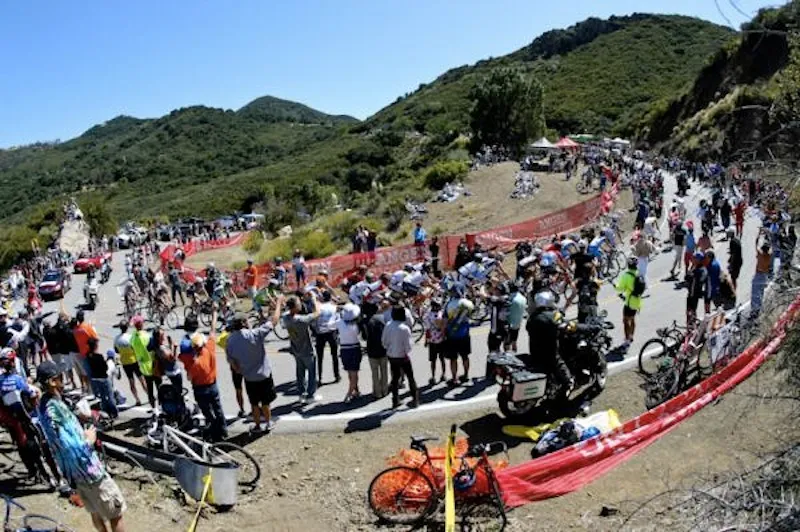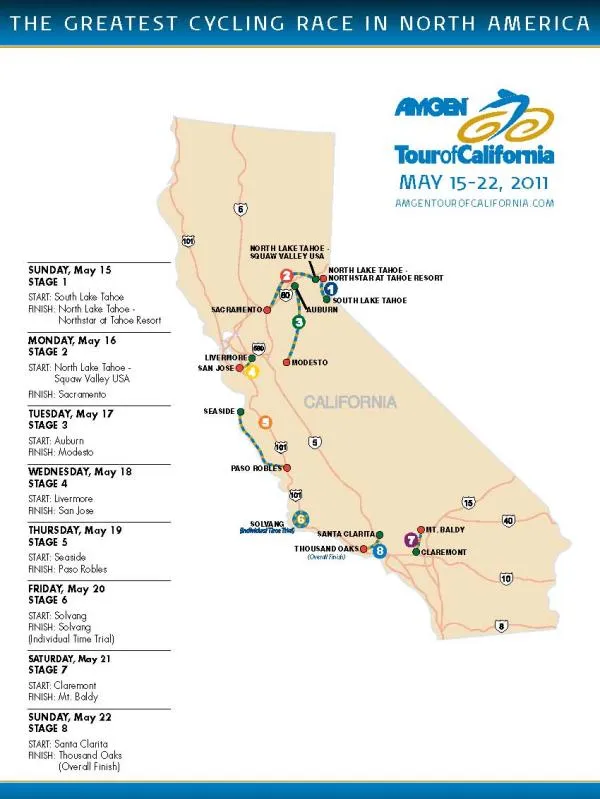After much speculation the 2011 Amgen Tour of California host cities have been announced. The sixth annual event will cover more than 800 miles, over eight stages, visiting 15 host cities from May 15-22, 2011.
While the exact route details are yet to be unveiled, AEG president Andrew Messick has confirmed that a number of key highlights will be included. Like last year, the race will start with a road stage as the route travels into Nevada for the first time. Mount Baldy will make its debut on the race’s penultimate Queen stage, and the Solvang time trial makes a return after a year’s absence.
“Now that we’re in May we want to make the most of the good weather and take the riders to the best places in order to race their bikes,” Messick told Cyclingnews.
As in 2010, the race will start with a road stage but unlike this year’s stage from Nevada City to Sacramento, the sprinters will struggle to shine. The stage begins with a lap and half around of Lake Tahoe before a tough finale up towards Northstar at Tahoe Resort.
“We’re putting in some harder, shorter, more decisive climbs because they’re exciting. The riders and the fans are telling us that they want to see that and we’re trying to respond as best we can. So we're getting to a place like Tahoe, which is a stunningly beautiful part of our state where we’ve never been before.”
In fact, listening to the fans’ feedback seems to be high on Messick’s list of priorities as he looks to grow the event. In total there are potentially four stages suited to the sprinters, meaning a return of Mark Cavendish is more than possible, while the climbers will have at least three stages, including the first stage, to shine.
The individual time trial, which is set to be longer than the 33.6km test from this year’s race should also give a number of riders including the likes of Levi Leipheimer, Michael Rogers and David Zabriskie, a shot at winning too.
“We want to be a race that people care about and to do that we need to create a race that captures peoples’ imagination and there are components to that. We need to have a course that’s exciting, riders and teams that are going to attract the attention and imagination of fans, and for us to do that we want to be responsive to what people care about. We have a race that’s shaping up to be very exciting.”
The inclusion of Mount Baldy will give the race it’s first truly mountain top finish. With over 2500ft of climbing and 18 switchbacks, it’s an attempt to add a Tour de France, Alpine experience to the race.
“It’s a legendary climb in southern California. It’s a hard climb and for us to be able to bring the athletes to the ski area mean it’s going be a hard and decisive day. It will be one of a number of stages where the race will be won and lost on. There will be multiple climbs on that stage, up to three major climbs.
“We expect the stages for the sprinters are to the ones to Sacramento, to Modesto, Paso Robles, and possiblly the final stage to Thousand Oaks. So stages 2, 3, 5 and 8. The first stage is more for an all-rounder,” said Messick.
Stage 4 from Livemore to San Jose should see the overall contenders make their mark. In previous editions of the race, the first mountain stage as acted as springboard for overall victory, but with Mount Baldy saved for what could be a truly epic stage 7, the race could come down to the wire as it did this year.
“We expect stage 4 to be a challenging mountain stage,” Messick said, who would not confirm if the day would end with a summit finish to Sierra Grade.
The final stage of the race will again finish at Thousand Oaks but Messick revealed that the format will change. ”It won’t be four laps again. We’ll be in a position in the coming weeks to announce what that stage will be like. It’s more likely that there will be chance that a sprinter could take it.”
The entire route looks like a mini-grand tour with enough opportunities to appease the pure sprinters, climbers and all-rounders. For Messick those elements are key in order to attract the biggest stars. With the race again clashing with the Giro d’Italia for the world's biggest names, Messick is hoping that his route will be enough to entice Europe's finest.
“We’re always looking for a balance. We want there to be opportunities for lot of different types of riders to win stages. We want to continue to go into new parts of the state. We want to have some really compelling stages that are going to be new and exciting for people and at the same time we want to go to places where we’ve had a lot of successes,” he said.
“So that’s why we’re coming back to a place like Solvang. It’s their 100-year anniversary in 2011. It’s a place where our race has had great success and where we think is emerging as one of the primary cycling destinations in America. It’s beautiful. A Friday afternoon time trial in the spring, it’s hard to imagine something better.”
- • Stage 1: Sunday, May 15 – South Lake Tahoe to North Lake Tahoe-Northstar at Tahoe Resort
- • Stage 2: Monday, May 16 – North Lake Tahoe-Squaw Valley USA to Sacramento
- • Stage 3: Tuesday, May 17 – Auburn to Modesto
- • Stage 4: Wednesday, May 18 – Livermore to San Jose
- • Stage 5: Thursday, May 19 – Seaside to Paso Robles
- • Stage 6: Friday, May 20 – Solvang Individual Time Trial
- • Stage 7: Saturday, May 21 – Claremont to Mt. Baldy
- • Stage 8: Sunday, May 22 – Santa Clarita to Thousand Oaks

